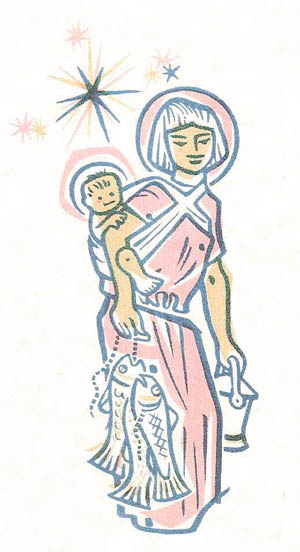By Barb Arland-Fye

More than 50 years ago, Vatican officials deemed a Davenport priest’s holy card artwork so objectionable that the St. Ambrose College art professor had to withdraw the holy cards from circulation. The late Father Edward Catich depicted Jesus, Mary and Joseph and the saints in contemporary attire. One holy card shows Joseph wearing bib overalls, holding a saw in one hand and resting his other hand on the shoulder of young Jesus, who wears a T-shirt and shorts and carries a toy sailboat in his arms. Another image of Jesus as an adult shows him being prepared for crucifixion. He is muscular, with bare chest. The belt on his trousers is unbuckled; a man in jacket and bow tie appears to be removing Jesus’ belt from his trousers. They are among 150 images that challenged conventional thinking in the mid-20th century.
Catich protégés are converting the holy cards to greeting cards as a fundraiser for the nonprofit Art Legacy League which they formed in 2012 to honor the life’s work of Fr. Catich. The priest, who died on Good Friday in 1979, founded St. Ambrose College’s art department and was a longtime art professor there. Considered to be one of the world’s finest calligraphers, he also was an expert on the Roman alphabet, its origin, nature and history. Fr. Catich’s work has been exhibited at the Metropolitan Museum of Art in New York City and at Harvard University in Cambridge, Mass.
“We want to continue Fr. Catich’s art education principles and make sure that his collection is properly displayed and preserved,” said Art Legacy League Chairman Paul Herrera, who is producing the greeting cards. Another of the league’s goals is to continue what Fr. Catich described as his “pictorial apostolate,” added Herrera, a calligrapher and retired teacher who was a student of the priest and then his apprentice.
Fr. Catich “considered himself an apostle; the best way he could be an apostle was through his artwork since he was an artist. That was his best form of communication,” explained Herrera. He quotes Fr. Catich from an article titled “The Image of Christ in Art:” “The function of religious art in all ages is to help people in their devotional needs; to help them approach more easily and understand more clearly divine truths; and ultimately to move them, by the aid of grace, to a closer union with God. To the extent that religious art does not do this it is not good religious art, whatever other merits it may possess in areas of technique and esthetic delight.”
Vatican concerns about Fr. Catich’s art
Fr. Catich began creating holy cards featuring contemporary images of saints, Jesus, Mary and Joseph around the 1940s, Herrera said. The priest agreed to withdraw the holy cards from circulation after a meeting with Bishop Ralph Hayes of the Davenport Diocese, who had received correspondence from Vatican officials objecting to the artwork. Then-Bishop Egidio Vagnozzi, Apostolic Delegate to the United States, wrote in a letter to Bishop Hayes dated July 26, 1961, “It is requested that Your Excellency caution the priest in question so that in his artistic activity he exercise more discipline in accord with the norms given by the Holy Office in the field of religious art, and particularly, that he observe the precepts set forth in the well-known Instruction of the Holy Office on Sacred Art, which was published on July 1, 1955.”
In a follow-up letter to Bishop Hayes, the Apostolic Delegate wrote with apparent consternation that “The Catholic Messenger of December 21, 1961, carried an article by the same priest with illustrations by him just like the cards to which the decision of the Sacred Congregation referred …”
Bishop Hayes responded in a letter dated Jan. 17, 1962, that the holy cards had been withdrawn from circulation and the illustrations which accompanied The Catholic Messenger article were not in the same vein as the “so-called ‘holy cards.’” Bishop Hayes noted that “I have talked with many of our priests regarding this type of illustration by Father Catich. Some do not agree with his basic ideas of art; I have met none who considered the illustrations a source of scandal.” The bishop promised that if the Holy Office “condemns this particular religious type of illustration, Father Edward Catich will immediately abide by the decision of the Supreme Congregation.”
“Father said to me several times that if he were ever forced to choose between the priesthood and art, he would choose the priesthood,” Herrera said.
Fr. Catich’s method of teaching art remains relevant
Few objections would likely be raised today. Fr. Catich’s Stations of the Cross slates, featuring the same style of artwork as the holy cards, are displayed on the walls of Christ the King Chapel at St. Ambrose University. Other religious art slates of Fr. Catich are displayed in various parishes around the diocese.
Fr. Catich may have had struggles with Church hierarchy, but he was a priest, artist and intellectual who dedicated his art and his life to his priesthood, observed artist John Bald. “That impressed me most of all.”
Artist Katie Kiley, who like Herrera and Bald was a Catich student, observed that the priest’s “no-nonsense, clear and deliberate approach to art was most appealing. Father was strict, but fair and I greatly appreciated his methodical, logical instruction, not to mention his quirky, forceful, yet wonderful ‘tough love’ character. And, of course, I greatly admired Fr. Catich’s graphic and calligraphic art and his amazing work ethic.”
She and the other Art Legacy League Board members “have profound love and respect for Father, and strongly believe that his method of teaching art remains relevant, effective and worth sharing.
“Fr. Catich’s holy cards are an ideal example of his beautiful and facile drawing style, and they demonstrate his ability to ‘say a lot’ with great economy.”
Greeting card details
Calligrapher Paul Herrera, chairman of the Art Legacy League, is creating greeting cards for sale that have been reproduced from holy card images designed by the late Father Edward Catich. The priest was a renowned calligrapher, artist and professor at St. Ambrose University in Davenport. Herrera uses a laser printer to produce 4-1/4-inch by 5-1/2-inch greeting cards which are blank inside. Fr. Catich disdained greeting cards where all the sender had to do was sign his or her name, Herrera explained. He wanted people to write a personal message inside.
Cards may be purchased for $2.50 each or 5 for $10 by contacting Herrera at paulh@artlegacyleague.org or via the U.S. Postal Service at 2304 Jersey Ridge Road, Suite 4, Davenport, Iowa, 52803.
The greeting cards serve as a fundraiser for the Art Legacy League, whose board members are comprised of former Catich students: Paul Herrera, chair; George Ohley, vice chair; Jeff Young, treasurer; directors Linda Kelty, John Bald, Katie Kiley, Amy Nielsen, Donna Young, Steve Morford; and webmaster Nancy Trottier.
The group has hosted several lectures and seminars across the U.S. and Canada since its inception in January 2012.
For more information about the Art Legacy League, visit www.artlegacyleague.org or email Herrera at paulh@artlegacyleague.org.









I’ve been trying to order Father Catich’s cards but can’t get your webside to respond. If you’ll help me out, I’ll send you my credit card number. I’d like three sets.
Thank you.
Ms. Doane,
Please contact me directly at the email address above and I will be happy to help you with your order.
We appreciate your support,
Paul
I have the same comment as S. Ruth Ellen Doane above. I would like to order some of Father Catich’s cards also. Please contact me. Thanks!
Ms. Spataru,
Please send me an email at my address above and I will be happy to process your request as well.
I thank you too for your support.
Paul
I want info on your greeting cards also. Especially looking for a 50th anniversary card.
Have not had luck with your website.
It would be great to reproduce more of Fr. Catich’s works. Are more of his maxims in the form of calligraphy? Words to live by and reminders we could display on the walls of our homes.
Thanks for bringing Fr. Catich’s work the spotlight.